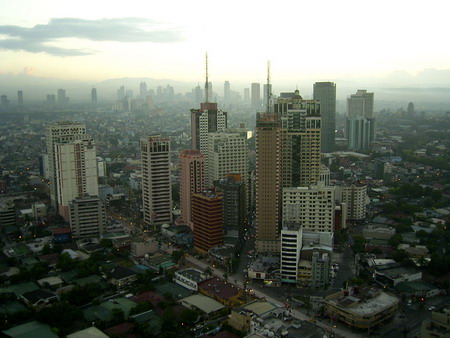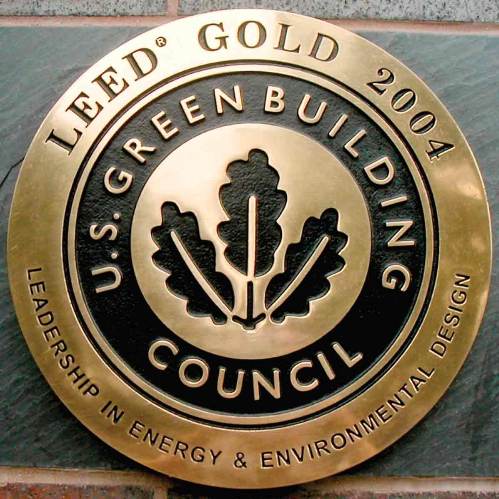This is a new idea to your business, and you’re wondering how you can convince the folks who wield the power to say yes to such a decision to agree that this is the best thing your business can do.

What to do? What to do? What to do?
Here are some ideas:
Put together a green “mission statement.” Present it to your boss and see if you can’t have a meeting with his or her boss and then ask to present it to the powers that be at your company. In this statement, do your research. Check out the Worldwatch Institute, the U.S. Green Building Council (USGBC) and other green sites for statistics about how much waste businesses in this country create.
Be sure to wow them with these nifty facts provided by the USGBC:
In the United States alone, buildings account for:
• 70% of electricity consumption,
• 39% of energy use,
• 39% of all carbon dioxide (CO2) emissions,
• 40% of raw materials use,
• 30% of waste output (136 million tons annually)
• 12% of potable water consumption.
Remind them that by going green your company also will:
Reduce operating costs
Enhance asset value and profits
Improve employee productivity and satisfaction
Optimize life-cycle economic performance
Hit ‘em over the head (gently) with the following fact, one that goes straight to your boss’ favorite line on her company’s balance sheet – the bottom one:
Back in 2005 the Commonwealth Fund reported that the year 2003 saw “407 million days of lost time at work” by sick employees.
If you can, find out how many sick days your company’s employees took last year. If all employees took just one fewer sick day per year off – and the USGBC reports that green (that is, healthy) buildings mean fewer sick days for employees – how much money would your company save a year? Not only in sick leave paid out, but in productivity gained?
Show that number to your boss, your company president, your HR director. Watch their eyes pop right up out of their heads and quickly ask for permission to get some folks together to research the benefits further.
And don’t be surprised how fast they’ll agree to your proposal.
[ add comment ] ( 46 views ) | [ 0 trackbacks ] | permalink |




 ( 3 / 566 )
( 3 / 566 ) LEED is popping up all over. We see it more and more as more and more people and see the benefits of working in and/or constructing a LEED-certified building.
But just what is LEED certification? What is the LEED lowdown?

A very short LEED primer: The acronym stands for Leadership in Energy and Environmental Design. Developed by the U.S. Green Building Council (USGBC) – a non-profit corporation which itself was created in 1993 – a LEED-certified building is one that conserves energy and is mindful within its design and construction of saving water, uses recycled materials whenever possible, provides a healthy indoor environment for the people who work within its walls and reduces the impact its construction has on the local environment, among a few other things, including innovation in sustainable design. A building must be in compliance with the requirements of the LEED Green Building Rating System to be LEED-certified.
Development and construction companies themselves cannot be LEED-certified, but a developer (or a provider of green office products such as GreenOfficeProjects.com – yes, shameless plug there) can help you build and furnish a building so that the structure will pass the LEED-certification process
For a builder to get her construction LEED-certified, she applies to the USGBC providing documentation that the building complies with LEED requirements.
LEED offers buildings four different levels of certification – Certified, Silver, Gold and Platinum (in other words, a building need not pass all of the LEED prerequisites to receive certification). Structures that score 40-50 percent on the LEED checklist may receive a Certified designation. Those buildings that score 80 percent or more receive a Platinum certification.
Constructing a LEED-certified building adds to a structure’s initial cost. Just as purchasing a compact florescent light (CFL) bulb costs more at first but saves money in the long run, so will the challenge and expense of constructing a LEED-certified building pay off over time.
Your company’s bottom line and our environment both win.
[ add comment ] ( 30 views ) | [ 0 trackbacks ] | permalink |




 ( 3 / 567 )
( 3 / 567 ) As “going green” gains momentum, companies are assessing new ways to make changes.
According to the US EPA, a typical office building’s energy usage represents 30% of its operating costs (CoStar Press Release). A large amount of that comes from wasted energy that could be dramatically reduced. Some of the offenders include office equipment left running day and night, outdated lighting and even large amounts of paper needlessly tossed out.

So where do you start?
First and foremost – educate employees to turn equipment off before leaving! Almost half of all office computers are left on all the time. Nights and weekends make up almost 75% of their usage. Unless you like paying higher utility bills, this simple change could save you big time!
For more energy savings, plug computers, FAX’s, copiers and other related office equipment into a power strip. Turn that off at night, then on again in the morning. There’s a new power strip that makes it even easier. Plug a computer and other peripherals into the new Ecostrip. When you turn your computer off at day’s end, it then powers down everything else. Simple, easy and inexpensive.
Office equipment uses lots of energy. To help reduce those costs, invest in ENERGY STAR equipment. These products use up to 60% less electricity than standard equipment. Now that’s some savings!
Consider installing motion detectors – in hallways, restrooms, anywhere there’s low traffic flow. Lights will turn on and off automatically when needed, and you’ll see a drop in your electric bill.
Another word about lighting. Standard lighting is a BIG energy waster. Make the switch to energy saving fluorescents (compact or tubes). This could cut your electric use 30-45
percent.
While you’re making changes, cut down on paper usage. Instead of sending office memos, why not distribute documents electronically? If you must do hard copies, reset your printers to use both sides of the paper. You not only save electricity, you cut paper consumption. And if you use paper with recycled content, you help the environment at the same time.
Most of these “fixes” are easy changes to make. And the difference to your bottom line could be startlingly positive. It pays to make changes.
[ add comment ] ( 130 views ) | [ 0 trackbacks ] | permalink |




 ( 3 / 571 )
( 3 / 571 ) Who would think furniture could be dangerous? Yet most traditional furniture is made with materials, paints and finishes that are highly toxic. These materials can cause a variety of allergic reactions, some quite severe.
Amazingly, one of the key culprits commonly used in furniture is formaldehyde! It’s used in furniture glue, as a preservative in paint, and is added to fabric to make it “permanent press.” The U.S. Consumer Product Safety Commission says “formaldehyde emissions can cause eye and throat irritation, allergic reactions and possibly cancer.”
That’s just the beginning of this tale.

Many of the absorbent materials used in draperies, upholstered furniture and carpeting can absorb, then release pollutants into the surrounding areas. This then can trigger asthma or other allergies.
Before you run out screaming to look for those plastic furniture covers your grandparents had, here are some things to watch out for to help you avoid some of this allergy-triggering quagmire.
First, steer clear of “stain resistant” furniture. And don’t use those stain resistant chemicals either. These conveniences can cause you trouble.
Stay away from products made with PVC. These include artificial leather, PVC-coated fabrics and vinyl furniture covers.
Watch out for furniture made with toxic flame retardants (PBDE’s). According to a recent report by the environmental group Friends of the Earth, “a high percentage of California furniture contains toxic chemicals that have been linked to cancer, birth defects, hormone disruption, and reproductive and neurological dysfunction.” These retardants are often used to meet California’s strict flammability regulations.
Non-PBDE furniture may not be easy to find, but one retailer can be counted on and that’s IKEA. Their products don’t use them.
There are a number of options for allergy-free, green office furniture. California-based Tamalpais Nature Works uses toxic-free finishes. Massachusetts-based Furnature makes elegant-looking sofas with organic upholstery. The number of companies providing these safer products is growing, as is the demand for them. And the prices and quality are comparable to traditional office furniture. With more people being diagnosed as chemically sensitive, relief may be in the form of a great new chair.
[ add comment ] ( 113 views ) | [ 0 trackbacks ] | permalink |




 ( 3 / 727 )
( 3 / 727 ) In the past few years large corporations have begun taking the green movement seriously. Since 1995, a diverse roster of companies like McDonald’s. Starbucks, and REI have built or refit their buildings and gained the LEED certification (Leadership in Energy and Environmental Design). There are also LEED certified Toyota showrooms and large office complexes like the 200 Market building in Portland, Oregon, the first multi-tenant LEED Existing Building (LEED EB) certified building in the country.

Offices around the country have been looking at how to be more “green”. For many, a new building isn’t an option. Even a LEED EB refit is out of the question. Other options and changes are being explored and implemented to create a more “earth friendly” environment.
There are, I’ve found, many shades of green. Does your company have a recycling program? If not, why not start one? Contacting your city’s solid waste division can score you the amount and type of recycling bins you’ll need. Then put together email memos or other company-wide notices announcing the program. Be sure to follow up periodically to remind everyone of the program and reinforce the importance of using it.
Want another “shade” to try? Why not switch from standard FAX to paperless online FAX? This will trim your electric bills and cut down paper usage.
If you search online, you’ll find there are a plethora of options for this. A few examples include eFax, online fax and Freefax. Some sites provide software you can download while others offer a toll-free phone number and monthly fees.
Whichever way you go – be it starting a recycling program, switching to online FAX or any other environmentally beneficial step – start somewhere. You and your employees will notice the difference.
[ 1 comment ] ( 43 views ) | [ 0 trackbacks ] | permalink |




 ( 3 / 662 )
( 3 / 662 ) 


 Looking for a Green Office Solution?
Looking for a Green Office Solution?